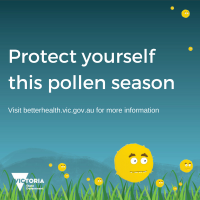 Grass pollen season brings an increase in asthma and hay fever. It also brings the chance of thunderstorm asthma. For people with asthma or hay fever, especially those who experience wheezing or coughing with their hay fever, thunderstorm asthma can be sudden, serious and even life threatening. That’s why it’s important for people with asthma or hay fever to know about thunderstorm asthma and what they can do to help protect themselves during grass pollen season.
Grass pollen season brings an increase in asthma and hay fever. It also brings the chance of thunderstorm asthma. For people with asthma or hay fever, especially those who experience wheezing or coughing with their hay fever, thunderstorm asthma can be sudden, serious and even life threatening. That’s why it’s important for people with asthma or hay fever to know about thunderstorm asthma and what they can do to help protect themselves during grass pollen season.
Epidemic thunderstorm asthma is where a large number of people develop asthma symptoms over a short period of time, thought to be triggered by a unique combination of high pollen levels and a certain type of thunderstorm. Grass pollen grains get swept up in the wind and carried for long distances, some can burst open and release tiny particles that are concentrated in the wind gusts that come just before a thunderstorm. These particles are small enough to be breathed deep into the lungs and can trigger asthma symptoms, making it difficult to breathe.
As grass pollen season approaches, here are some things you can do to prepare for pollen season:
If you’ve ever had asthma – talk to your doctor about what you can do to help protect yourself from the risk of thunderstorm asthma this pollen season. Remember taking an asthma preventer properly and regularly is key to preventing asthma, including thunderstorm asthma.
If you have hay fever – see your pharmacist or doctor for a hay fever treatment plan and check if you should have an asthma reliever puffer – which is available from a pharmacy without a prescription.
If you have hay fever, and especially if you experience wheezing and coughing with your hay fever, it is important to make sure you don’t also have asthma. Speak to your doctor today about whether or not you might have asthma.
It’s important for everyone in the community to know the four steps of asthma first aid so they know what to do if they or someone is having an asthma attack.
And finally, where possible avoid being outside during thunderstorms from October through December – especially in the wind gusts that come before the storm. Go inside and close your doors and windows. If you have your air conditioning on, turn it onto recirculate.
For more information about thunderstorm asthma and how to protect yourself, visit https://www.betterhealth.vic.gov.au/
